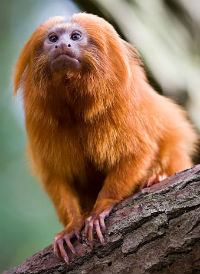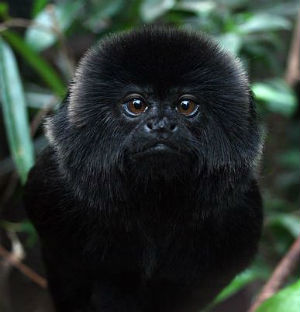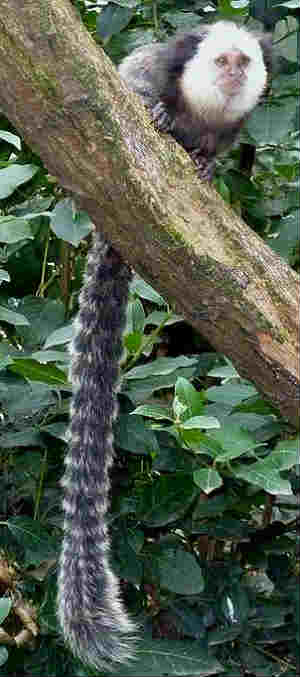Tamarin and Marmoset Hybrids
Family Callitrichidae
Mammalian Hybrids
EUGENE M. MCCARTHY, PHD GENETICS, ΦΒΚ

|
|
Golden Lion Tamarin (Leontopithecus rosalia)
Image: Jeroen Kransen, Wikimedia |

|
|
Goeldi’s Tamarin (Callimico goeldii) |

|
|
Geoffroy’s Tufted-ear Marmoset (Callithrix geoffroyi) |
Note: Doimbra-Filho et al. (1993, p. 120) say “hybrids of all of the south-east Brazilian marmosets are genetically fertile, [and this hybridization] “along with founder effects and genetic drift may cause rapid ‘speciation’, or at least the production of localized uniformly distinct, true-breeding phenotypes.”
Callithrix argentata [Silvery Marmoset]
× Callithrix jacchus (↔) [White-tufted Marmoset] CHR. CON: northeastern Brazil (Maranhão)? Hill says the adult hybrid was very similar to C. argentata. Hershkovitz (1977, p. 444) says the parents compose the most distantly related pair in the genus. English 1932; Hill 1961; Jersey Wildlife Preservation Trust Annual Report, 1971 (No. 8, p. 27). Internet: tinyurl.com/hey3grd.
× Callithrix humeralifera [Santarém Marmoset] ENHI(southeastern Amazonas, Brazil). A population intermedia, has been treated as race of both these marmosets, and sometimes separately (as Hershkovitz’s Marmoset). Rylands et al. 1993 (Fig. 1.2, and pp. 36-37).
Note: Moojen (1950) says two populations, aurita and caelestis, treated as races of Callithrix aurita, hybridize in southern Brazil. However, Hershkovitz (1977, p. 524) found nothing in specimens examined or in published reports that warrants separation of caelestis from aurita.
Callithrix aurita [Buffy-tufted Marmoset]
× Callithrix flaviceps [Buffy-headed Marmoset] ENHR(e Brazil). There is a hybrid zone at Carangola in the Serra do Brigadeiro (southeastern Minas Gerais). Coimbra-Filho 1993 (p. 115); Cosenza 1993; Cosenza and de Melo 1998; Ferrari and Mendes 1991; Mendes 1997.
Callithrix flaviceps [Buffy-headed Marmoset]
See also: Callithrix aurita
× Callithrix geoffroyi (♀) [Geoffroy’s Tufted-ear Marmoset] CAENHR. There is a hybrid zone in eastern Brazil (e Minas Gerais, Espíritu Santo, vicinity of Santa Teresa). The zone is altitudinal (flaviceps occurs above geoffroyi). Mixed groups with hybrids occur between 500 and 850 m. Hershkovitz gives a detailed description of a hybrid in the Museu Nacional/UFRJ, Rio de Janeiro (specimen MNRJ 5878). Coimbra-Filho 1971; Coimbra-Filho et al. 1981; Coimbra-Filho and Mittermeier 1973; Hershkovitz 1977 (pp. 1015-1016); Mendes 1989, 1993, 1997.
Callithrix geoffroyi [Geoffroy’s Tufted-ear Marmoset]
See also: Callithrix flaviceps.
× Callithrix jacchus (♂) [White-tufted Marmoset] CAENHR(Rio de Janeiro). HPF(♂&♀). DRS (ranges are separated by that of C. penicillata). Two sets of twins were born to a single pair. The first were normal; the second, blind. The same pair latter had triplets, each of which was blind in the left eye. Triplet three-way hybrids were produced with a C. penicillata female. One survived and, upon maturity, resembled a pure C. penicillata. Coimbra-Filho 1970, 1971, 1973; Coimbra-Filho and Maia 1976; Coimbra-Filho and Mittermeier 1973†; Coimbra-Filho et al. 1976.
× Callithrix penicillata [Black Tufted Marmoset] CAENHR(e Brazil). HPF. These taxa are sometimes lumped. Rylands and Faria (1993, p. 270) say narrow hybrid zones occur in Minas Gerais. Contact occurs, too, in southern Bahia and in southern Espíritu Santo, between Rio Jucu and Rio Itaunas. Hershkovitz (1977) says Wied’s Black-tufted Marmoset (Callithrix kuhli) is this hybrid. He examined three specimens assigned to C. kuhli collected near Ilhéus and asserted (p. 503) that “their geographic position, buffy crown pale cheeks, well-defined white median rostral line and large frontal blaze extending over the crown mark them as intergrades [i.e., hybrids] between geoffroyi and penicillata.” He also says (p. 504) that they are indistinguishable from captive born penicillata × geoffroyi hybrids, and that specimens from near Ilhéus are more similar to penicillata; those from the vicinity of the Rio Belmonte, more like geoffroyi (which, incidentally, indicates hybrids are capable of backcrossing to their parents of either type). Hershkovitz (1977) lists museums holding specimens of probable hybrids. However, the situation is not clear because Rylands et al. (1993, pp. 42-43) say captive hybrids differ from C. kuhli. Coimbra-Filho et al. 1993 (p. 110) say “we regard the form in southern Bahia, at least between the Rio de Contas in the north and the Rio Jequitinhonha in the south, to be a valid taxon, C. kuhli.” Three-way hybrids with Callithrix jacchus have been reported. Coimbra-Filho 1974; Coimbra-Filho and Mittermeier 1973; Coimbra-Filho et al. 1976; 1993; Hershkovitz 1975 (pp. 142-144), 1977 (pp. 503-505, 509, 1017); International Zoo Yearbook 1980 (p. 421), 1981 (p. 308), 1982 (p. 410), 1983 (p. 312); Wied (1826, p. 142).
Callithrix jacchus [White-tufted Marmoset]
See also: Callithrix argentata; C. geoffroyi.
× Callithrix penicillata (♂) [Black Tufted Marmoset] CAENHR(e Brazil). HPF(♂&♀). Formerly very common in captivity. A single pair of F₁ hybrids produced five litters at the Jersey Zoo (UK). Hershkovitz (1977, p. 1017) says these marmosets “are completely intergrading in nature” (i.e., they have a hybrid zone). Specifically, Rylands and de Feria (1993, p. 270) say there is a narrow hybrid zone in eastern Bahia, were their ranges meet on the coast (Santo Amaro). Contact also occurs inland (Rio Grande and Rio São Francisco valleys). Coimbra-Filho and Mittermeier (1973, p. 244) say this is the most common Callithrix hybrid in captivity because these marmosets are the two most often kept. These taxa are sometimes lumped, but Alonso et al. argued that the narrowness of the hybrid zone suggests that they should be treated as separate species. Alonso et al. 1987; Chiarelli 1961; Coimbra-Filho 1971; Coimbra-Filho and Mittermeier 1973; Coimbra-Filho et al. 1993; Hampton et al. 1971 (p. 528); Hershkovitz 1975 (p. 149, 1017)†, Hill 1957 (pp. 185, 288, 296), 1961; International Zoo Yearbook 1967 (p. 303), 1968 (p. 291), 1969 (p. 219), 1970 (p. 253), 1971 (p. 263); Mallinson 1971 (p. 81), 1973 (p. 321), 1974 (p. 369), 1975 (p. 361), 1977 (p. 303), 1978 (p. 372) 1979 (p. 351), 1980 (p. 421), 1981 (p. 308), 1982 (p. 410), 1983 (p. 312), 1984/1985 (p. 514).
× Cebuella pygmaea (♂) [Pygmy Marmoset] CHR. DRS. Neusser et al. (2005) reported one hybrid of each sex.
Callithrix kuhli [Wied’s Black-tufted Marmoset]
× Callithrix penicillata [Black Tufted Marmoset] ONHR(e Brazil). HPF(vh). Hybrids occur on left the bank of Rio Jequitinhonha in northernmost Minas Gerais (16°41´S,40°51´W) and in Bahia as far north as Valença an Nazaré (to just south of Salvador). Hybrids vary in color. See Callithrix geoffroyi × C. penicillata. International Zoo Yearbook 1983 (p. 312); Mittermeier et al. 1988b; Oliver and Santos 1991; Rylands et al. 1993 (p. 43).
Callithrix penicillata [Black Tufted Marmoset] See: Callithrix geoffroyi; C. jacchus; Callithrix geoffroyi × C. jacchus; Callithrix kuhli. Two populations (jordani, penicillata), treated as races of C. penicillata, have a hybrid zone in eastern Brazil (Recôncavo da Bahia). Hershkovitz 1975 (pp. 147-149)†.
Cebuella pygmaea [Pygmy Marmoset] See: Callithrix jacchus.
Leontopithecus chrysomelas [Golden-headed Lion Tamarin]
× Leontopithecus rosalia (♂) [Golden Lion Tamarin] CHR. DRS. A single pair produced two litters of twins, and a singleton. The hybrids were all full-term and physically normal, but none lived more than a day, apparently because the captive-raised mother had no experience in raising young. These taxa are often lumped, but are markedly different in coloration. Coimbra-Filho et al. 1976; Hershkovitz 1977 (p. 1032).
Leontopithecus rosalia [Golden Lion Tamarin]
See also: Leontopithecus chrysomelas.
× Canis familiaris [Domestic Dog] See the separate article “Domestic Dog × Primate”
Saguinus bicolor [Pied Bare-faced Tamarin]
× Saguinus martinsi [Martin’s Bare-faced Tamarin] CHR. ENHI? CON: Amazon (n bank, below Manaus). A population, ochraeus, is geographically intermediate (it is known to occur on the western bank of Rio Nhamundá), and Hershkovitz’s (1977, p. 747) description suggests it to be morphologically intermediate as well, which suggests it as a PHP of this cross. These tamarins are often treated as conspecific. Meireles et al. 1998.
× Saguinus midas (♀) [Red-handed Tamarin] CHR. HPF(♂&♀). Here, hybrids of both sexes are presumed fertile by Haldane’s rule, since a partially fertile male has been reported. Parapatric contact zone north of Manaus, Brazil (Urubu Valley). The hybrid shown in Immendorf’s figure 5 has the face of an adult S. bicolor, but is otherwise similar to S. midas. Hershkovitz 1977 (pp. 444, 721, 724); Hick 1961; Immendorf 1961†; International Zoo Yearbook 1959 (p. 140), 1961 (p. 257).
Note: Hybrids between various forms often treated as races of Saguinus fuscicollis have been reported in captivity (illigeri × lagonotus, lagonotus × leucogenys, lagonotus × nigricollis). Gengozian 1969 (p. 338); Hershkovitz 1977 (p. 444); Roth 1960.
Note: In his History of Four-Footed Beasts (1608) Edward Topsell, who called them "sagoins," proposed a weird and far-fetched hybrid origin for tamarins. He claimed that it is "very probable that they are conceived by a small Ape and Weasell, for in that Countrey, by reason of the heat thereof, there are many such unnatural commixtions."
Saguinus fuscicollis [Saddle-backed Tamarin]
× Saguinus illigeri [Illiger’s Tamarin] CHR. These tamarins are now often treated as conspecific. Hershkovitz 1977 (p. 444).
× Saguinus labiatus [Red-chested Moustached Tamarin] These tamarins occur in mixed groups in northwestern Bolivia. No hybrids as yet reported. Callimico goeldii (Goeldi’s Tamarin), too, was consistently seen in the same groups. See: Pook and Pook 1982.
× Saguinus melanoleucus (↔) [White-mantled Tamarin] HPF. ENHR(Cruzeiro do Sul, Brazil). These tamarins are sometimes lumped. They are separated in Brazil by the Rio Juruá, but come into contact toward its headwaters, the location of the hybrid zone. A full range of intermediates occur. The occurrence of both fuscicollis and melanoleucus mtDNA haplotypes in hybrids implies reciprocal hybridization occurs, which indicates that the hybrids must be at least partially fertile. The IUCN says acrensis is a hybrid of this type, and that crandalli probably is, too. Hershkovitz 1977; Peres et al. 1996.
× Saguinus nigricollis (↔) [Black-mantled Tamarin] CHR. HPF(♂&♀). CON: northern Peru (east bank of Rio Tapiche). These taxa are sometimes lumped. Deinhardt et al. 1976; Gengozian 1969 (p. 358); Hershkovitz 1977 (p. 444); Wolfe et al. 1975.
Saguinus geoffroyi [Geoffroy’s Tamarin]
× Saguinus oedipus (♂) [Cotton-top Tamarin] CHR. Parapatric contact zone in ext. northwestern Colombia (lower Rio Atrato). Epple 1970 (p. 1966).
Note: Illiger’s tamarin is now usually treated as a subspecies of Saguinus fuscicollis
Saguinus illigeri [Illiger’s Tamarin]
× Saguinus nigricollis (↔) [Black-mantled Tamarin] CHR. CON: northern Peru (Rio Tapiche). In addition to mentioning known captive Snowden (1982, p. 224), mentions an individual from the contact zone whose call combined traits of both parents. Duff and Lawson (2004) lump these taxa.
Note: Hybrids have been reported between two types of tamarin (imperator, subgriscesens) treated as races of Saguinus imperator. International Zoo Yearbook 1990 (p. 431), 1991 (p. 338).
Saguinus imperator [Emperor Tamarin]
× Saguinus labiatus [Red-chested Moustached Tamarin] NHR(northern Bolivia)? Izawa and Bejarano (1981) report the sighting of a putative hybrid. Parapatric contact zone at the juncture of Bolivia, Peru, and Brazil.
× Saguinus mystax (♂) [Black-chested Moustached Tamarin] CHR. The pregnant mother died of a fall, twin fetuses in an advanced stage of development were found during necropsy. Da Cruz Lima 1945.
Saguinus labiatus [Red-chested Moustached Tamarin]
See also: Saguinus fuscicollis; S. imperator.
× Saguinus mystax [Black-chested Moustached Tamarin] CHR. Parapatric contact zones in eastern Brazil (Rylands et al. 1993 Figs. 1.5, 1.6). International Zoo Yearbook 1983 (p. 313).
Saguinus martinsi [Martin’s Bare-faced Tamarin] See: Saguinus bicolor.
Saguinus melanoleucus [White-mantled Tamarin] See: Saguinus fuscicollis.
Saguinus midas [Red-handed Tamarin]
See also: Saguinus bicolor.
× Saguinus oedipus (♂) [Cotton-top Tamarin] CHR. Benirschke 1969; Hershkovitz 1968 (p. 572), 1977 (pp. 444, 721-723†); International Zoo Yearbook 1966 (p. 388); Low and Benirschke 1968; Smithsonian Institution 1965 (p. 113, pl. 3).
Saguinus mystax [Black-chested Moustached Tamarin] See: Saguinus imperator.
Saguinus nigricollis [Black-mantled Tamarin] See: Saguinus fuscicollis; S. labiatus.
Saguinus oedipus [Cotton-top Tamarin] See: Saguinus midas.
By the same author: Handbook of Avian Hybrids of the World, Oxford University Press (2006).